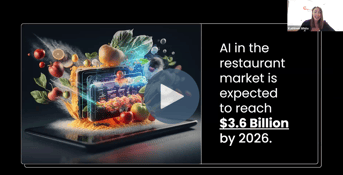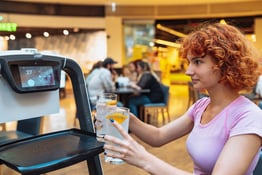In 2020, Rachel's Kitchen adapted an off-premise pricing strategy not all that different from rideshare platforms, like Uber or Lyft. Order delivery from the Las Vegas Valley bistro during the lunch rush, and you’re likely to encounter higher prices for its sandwiches and salads than if browsing its Grubhub menu just two hours later.
The concept is known as dynamic pricing, a strategy that involves changing prices based on demand, and an increasing number of platforms are joining the market to help restaurants adopt the approach.
“This has been happening in the travel world for years, and everyone’s aware of how that works, so when Sauce called us during the pandemic, we decided to go for it,” says Debbie Roxarzade, founder and CEO of Rachel’s Kitchen, on working with dynamic pricing platform Sauce. “At the time our stores had gone to takeout only and we didn’t have much to lose, and now it’s just become a set-it-and-forget-it tool we use to help offset the costs of third party pricing.”
Dynamic pricing is now being implemented at three Rachel’s Kitchen locations in partnership with Sauce, and it’s paying off. After four months on the platform, one location saw a 64% increase in revenue, and online sales jumped from $18,726 to $30,832 per month. At this point, dynamic pricing has become part of the business model, says Roxarzade, noting that in most cases, customers haven’t recognized the change.
“I think on delivery platforms, the price fluctuations largely go unnoticed, but if and when we decide to do dynamic pricing in-store, we’d educate our team about how to explain it to people,” says Roxarzade.
How does dynamic pricing work?
Dynamic pricing involves making real-time price changes based on market demand, often taking into account factors like day of the week, time of day, seasonality, market competition, and even environmental constraints, like the weather. The strategy’s been around long before platforms like Uber came to market. Consider the price difference of booking a flight or a hotel room during the holiday season, for example, as opposed to a random day in March.
“Consumers are exposed to dynamic pricing with almost everything they’re buying online, and restaurants finally have a digital access point to consumers that enables them to join the rest of the world,” says Colin Webb, co-founder of Sauce. “Being able to have supply match the changing demand makes your market a lot more efficient.”
In recent years, the restaurant industry has gone through a digital evolution, increasingly embracing an array of tools like QR code menus, digital menu boards, ordering kiosks, and online ordering platforms. Right now, early restaurant adopters of dynamic pricing are mainly using the strategy for delivery and takeout business. But Webb expects it won’t be long before it spreads to all forms of digital ordering.
“We’ve seen restaurants that have gone from a 5% margin to a 10% margin, and restaurants that have gone from a 10% margin to a 20% margin, which is insane,” says Webb. “It revolutionizes the concept of profitability in a restaurant.”
What does it look like to partner with a dynamic pricing platform?
Operators don’t need to work with a technology partner to implement dynamic pricing. Any restaurant can change prices throughout the day or week. It’s even easier if you’re using a digital menu, which eliminates having to constantly head to the printer. But an emerging crop of companies, like Sauce, along with DynamEat, Juicer, and Priceff, want to make it even simpler by automating the process.
“We look at your historical sales, your orders, your customer retention, and click through rate on [online ordering] platforms, and will create unique pricing strategies depending on what goals the restaurant is trying to drive, whether that’s to increase check size, reduce food costs, or fill off-peak times,” says Webb. “With these data-driven, pre-populated strategies, you can press play right off the bat.”
Sauce integrates with a variety of POS systems, delivery platforms, and middleware aggregator platforms to automatically pull in historical sales data. This gets plugged into an algorithm that creates the pricing strategies. Operators then set thresholds to cap how high and low prices will fluctuate away from their base menu pricing, typically going through several weeks of trial and error to find the sweet spot.
“We played around a lot at the beginning to find the maximum price we could use before we started to lose business and to look at when we were selling our product for too low,” says Roxarzade. “Currently we’re increasing [menu items] by 10% for peak hours and decreasing prices by 5% for off-peak hours.”
Most platforms also give operators the ability to create their own pricing strategies outside of those suggested by the algorithm. For example, if a restaurant wants to test out increasing late-night pricing, the operator can schedule prices to go up starting at midnight, and then set it to automatically trigger every night.
“It’s about looking at the pockets of time, and depending on the restaurant and the level of volatility, that could mean making one to two price changes a day, or maybe three to four a week,” says Carl Orsbourn, co-founder of Juicer, currently piloting its dynamic pricing platform with 10 restaurant groups. “It might be on a Friday night that you see a price increase, or you might reduce the price of beverages and desserts and sides on a Monday between 3 p.m. and 6 p.m. if you're trying to drive volume into the restaurant.”
Orsbourn says a reasonable goal is to find a strategy that grows your revenue by five to ten percent.
Should your restaurant partner with a dynamic pricing platform?
As with most tech platforms, there’s a cost to partnering with dynamic pricing companies. Sauce, for example, charges a $75 subscription fee, plus 10% on incremental price markups. In other words, if you usually charge $10 for a breakfast sandwich but increase it to $11 for the breakfast rush, Sauce gets 10% of that $1 markup, or 10 cents per order.
Once Juicer emerges from its piloting stage, the company expects to charge somewhere between $300 to $500 per unit per month for its platform.
Determining the payoff generally comes down to a restaurant’s online sales. “We’re mostly focused on folks that have a high amount of digital orders,” says Webb.
Where is dynamic pricing headed in the future?
While dynamic pricing is already commonplace in the travel industry, it’s still largely in its infancy stage within the restaurant industry. More and more influential brands, however, are expected to test out the strategy in 2023, and that’s likely to catapult into a mainstream approach.
For now, QSRs and fast casuals are the primary adopters, given their dominance in the delivery and online ordering market. Yet, that doesn’t mean there isn’t room for dynamic pricing in other sectors.
“You’re already starting to see fine dining restaurants take this approach from a table reservation standpoint, where you have folks on a Friday night pay $400 dollars to reserve a table,” says Webb, nodding to how some trendy reservations are being sold like concert tickets. “In the near future, I think we’ll see the folks with QR code menus also take that next step with dynamic pricing just because it’s more efficient.”
If dynamic pricing takes off, it’s likely to infiltrate restaurants’ loyalty program strategies, too, and affect promotional strategies as a whole. After all, dynamic pricing is essentially a more complex version of happy hour. This creates potential opportunities for consumers, too, to seek out bargains or pay more for convenience.
“It’s like when I shop on Instacart, and I have the option to pay $2 more to get my order within 30 minutes as opposed to the next 2 hours,” says Webb. “We’re going to see the expansion of dynamic pricing with anything you can do on a digital interface.”
Grace Dickinson is a reporter at Back of House. Send tips or inquiries to grace@backofhouse.io.
[Photo courtesy Ivan Samkov]





